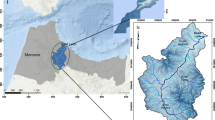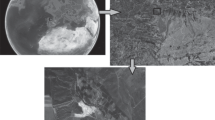Abstract
According to EU flood risks directive, flood hazard maps should include information on hydraulic characteristics of vulnerable locations, i.e. the inundated areas, water depths and velocities. These features can be assessed by the use of advanced hydraulic modelling tools which are presented in this paper based on a case study in the river Lima basin, Portugal. This river includes several flood-prone areas. Ponte Lima town is one of the places of higher flood risk. The upstream dams can lower the flood risks if part of its storage capacity is allocated for mitigating flood events. However, proper management of dam releases and the evaluation of downstream river flows should be considered for preventing flood damages. A hydrological and a one-dimensional hydrodynamic model were implemented, and at a particular flood-prone town, inundation was assessed using a two-dimensional model. The hydrological model is based on the well known Sacramento model. For this purpose, two different modelling implementations were analysed: a model based on a finite element mesh and a model based on rectangular grids. The computational performance of the two modelling implementations is evaluated. Historical flood events were used for model calibration serving as a basis for the establishment of different potential flood scenarios. Intense precipitation events in the river’s basin and operational dam releases are determinant for the occurrence of floods at vulnerable downstream locations. The inundation model based on the unstructured mesh reveals to be more computationally efficient if high spatial resolution is required. A new combination of software tools for floods simulation is presented including an efficient alternative for simulation of 2-D inundation using a finite element mesh instead of a grid.







Similar content being viewed by others
References
Adeloye A, Rustum R (2011) Lagos (Nigeria) flooding and influence of urban planning. J Urban De Plan 164–3:175–187
AQUAVEO (2009) SMS Surface Water Modeling System 10.0 Tutorial
ARHN (2012) Management Plan of the Minho and Lima River Basin District. Water Resources Authority of the Northern Region of Portugal. Porto
De Roo A, Gouweleeuw B, Thielen J, Bartholmes J, Bongioannini-Cerlini P, Todini E, Bates P, Horritt M, Hunter N, Beven K, Pappenberger F, Heise E, Rivin G, Hills M, Hollingsworth A, Holst B, Kwadijk J, Reggiani P, van Dijk M, Sattler K, Sprokkereef E (2003) Development of a European flood forecasting system. Int J River Basin Manag 1:49–59
Demir I, Krajewski WF (2013) Towards an integrated flood information system: centralized data access, analysis, and visualization. Environ Model Softw 50:77–84
ERDC (2013) ERDC: Engineering Resource Development Center. http://www.erdc.usace.army.mil/ Accessed in March 2013
EU (2007) Directive of the European Parliament and of the Council 2007/60/EC, establishing a framework for the assessment and management of flood risks. Official Journal 2007 L 288/27, European Commission, Brussels
Ferreira R (2010) Flood modeling in urban areas. MSc thesis in Urban Engineering. University of Minho
Filatova T (2014) Market-based instruments for flood risk management: a review of theory, practice and perspectives for climate adaptation policy. Environ Sci Pol 37:227–242
Liang Q (2010) Flood simulation using a well-balanced shallow flow model. ASCE J Hydr Eng 136(9):669–675
Liu W, Chen W, Peng C (2014) Assessing the effectiveness of green infrastructures on urban flooding reduction: a community scale study. Ecol Model 291:6–14
Néelz S, Pender G (2010) Benchmarking of 2D Hydraulic Modelling Packages, SC080035/R2 Environment Agency, Bristol, UK
Penning-Roswell EC, Tunstall SM, Tapsell SM, Parker DJ (2000) The benefits of flood warnings: real but elusive and politically significant. J Inst Wat Environ Manag 14:7–14
Pinho JLS, Vieira JMP (2005) Mathematical modeling of salt water intrusion in a Northern Portuguese estuary. Fourth Inter Celtic Colloquium on Hydrology and Management of Water Resouces, Guimarães, Portugal
Pinho JLS, Vieira JMP, Carmo JSA (2004) Hydroinformatic environment for coastal waters hydrodynamics and water quality modelling. Adv Eng Softw 35:205–222
Renner M, Werner MGF, Rademacher S, Sprokkereef E (2009) Verification of ensemble flow forecasts for the River Rhine. J Hydrol 376:463–475
Shahapure SS, Eldho TI, Rao P (2010) Coastal urban flood simulation using FEM, GIS and remote sensing. Water Resour Manag 24:3615–3640
Sharma CS, Mishra A, Panda SN (2014) Assessing impact of flood on river dynamics and susceptible regions: geomorphometric analysis. Water Resour Manag 28:2615–2638
Sprague RH, Carlson ED (eds) (1982) Building effective decision support systems. Prentice-Hall, Englewood Cliffs
Stelling GS, Verwey A (2005) Numerical Flood Simulation. Encyclopedia of Hydrological Sciences, vol. 1. John Wiley & Sons Ltd., pp 257–270
Tsakiris G, Bellos V (2014) A numerical model for Two-dimensional flood routing in complex terrains. Water Resour Manag 28:1277–1291
Verwey A (2005) Hydroinformatics support to flood forecasting and flood management. Fourth Inter Celtic Colloquium on Hydrology and Management of Water Resouces, Guimarães, Portugal
Vieira J, Pinho J, Pinho R, Araújo J (2012) A web based decision support system for water quality management in a large multipurpose reservoir. 10th International Conference on Hydroinformatics HIC 2012, Hamburg, Germany
Werner M, van Dijk M, Schellekens J (2004) Delft FEWS: An open shell flood forecasting system, in Liong, Phoon and Babovic (Eds.) 6th International Conference on Hydroinformatics, Singapore, 1205–1212
WL (2005) SOBEK – Reference Manual. Delft Hydraulics, Netherlands
Yazdi J, Neyshabouri SAA (2014) Adaptive surrogate modeling for optimization of flood control detention dams. Environ Model Softw 61:106–120
Zagonari F, Rossi C (2013) A heterogeneous multi-criteria multi-expert decision-support system for scoring combinations of flood mitigation and recovery options. Environ Model Softw 49:152–165
Author information
Authors and Affiliations
Corresponding author
Rights and permissions
About this article
Cite this article
Pinho, J., Ferreira, R., Vieira, L. et al. Comparison Between Two Hydrodynamic Models for Flooding Simulations at River Lima Basin. Water Resour Manage 29, 431–444 (2015). https://doi.org/10.1007/s11269-014-0878-6
Received:
Accepted:
Published:
Issue Date:
DOI: https://doi.org/10.1007/s11269-014-0878-6




